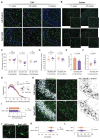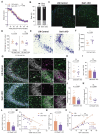This is a preprint.
Microglial SWELL1 Deficiency Drives Male-Specific Seizure Vulnerability but Paradoxical Neuroprotection through Impaired Phagocytosis
- PMID: 40501741
- PMCID: PMC12154700
- DOI: 10.1101/2025.05.26.656163
Microglial SWELL1 Deficiency Drives Male-Specific Seizure Vulnerability but Paradoxical Neuroprotection through Impaired Phagocytosis
Abstract
The discovery of genes encoding the volume-regulated anion channel (VRAC) has enabled detailed exploration of its cell type-specific roles in the brain. LRRC8A (SWELL1) is the essential VRAC subunit. We observed seizure-induced, subunit-specific changes in microglial VRAC expression and investigated its function using conditional knockout (cKO) of LRRC8A in microglia. SWELL1 cKO mice exhibited a male-specific increase in kainate-induced seizure severity yet showed paradoxical neuroprotection against seizure-associated neuronal loss. Mechanistically, SWELL1 deletion led to a cell-autonomous reduction in microglial density and decreased release of VRAC-permeable neuroactive metabolites, including taurine, GABA, and glutamate in culture. Additionally, impaired phagocytic kinetics and reduced lysosomal biogenesis contributed to the observed neuroprotection. These findings reveal novel roles for microglial VRAC in regulating seizure outcomes and microglia-neuron interactions.
Keywords: Epilepsy; SWELL1; VRAC; microglia; neuroprotection; phagocytosis; seizures; sex-differences.
Conflict of interest statement
Competing interests The authors declare no competing interests in relation to this work.
Figures






Similar articles
-
LRRC8A Regulates Outer Hair Cell Volume and Electromotility and is Required for Hearing.Adv Sci (Weinh). 2025 Jul 11:e10477. doi: 10.1002/advs.202410477. Online ahead of print. Adv Sci (Weinh). 2025. PMID: 40642832
-
Carbamazepine versus phenytoin monotherapy for epilepsy: an individual participant data review.Cochrane Database Syst Rev. 2017 Feb 27;2(2):CD001911. doi: 10.1002/14651858.CD001911.pub3. Cochrane Database Syst Rev. 2017. Update in: Cochrane Database Syst Rev. 2019 Jul 18;7:CD001911. doi: 10.1002/14651858.CD001911.pub4. PMID: 28240353 Free PMC article. Updated.
-
The SWELL1-LRRC8 complex regulates endothelial AKT-eNOS signaling and vascular function.Elife. 2021 Feb 25;10:e61313. doi: 10.7554/eLife.61313. Elife. 2021. PMID: 33629656 Free PMC article.
-
Lamotrigine versus carbamazepine monotherapy for epilepsy: an individual participant data review.Cochrane Database Syst Rev. 2018 Jun 28;6(6):CD001031. doi: 10.1002/14651858.CD001031.pub4. Cochrane Database Syst Rev. 2018. PMID: 29952431 Free PMC article.
-
Kininogen enhances seizure susceptibility in mice possibly through bradykinin-induced modulation of calcium transients in glutamatergic and GABAergic neurons.Front Pharmacol. 2025 Jun 10;16:1509837. doi: 10.3389/fphar.2025.1509837. eCollection 2025. Front Pharmacol. 2025. PMID: 40556759 Free PMC article.
References
-
- Dardiotis E., Siokas V., Pantazi E., Dardioti M., Rikos D., Xiromerisiou G., Markou A., Papadimitriou D., Speletas M., Hadjigeorgiou G. M., A novel mutation in TREM2 gene causing Nasu-Hakola disease and review of the literature. Neurobiology of Aging 53, (2017). - PubMed
-
- Papapetropoulos S., Pontius A., Finger E., Karrenbauer V., Lynch D. S., Brennan M., Zappia S., Koehler W., Schoels L., Hayer S. N., Konno T., Ikeuchi T., Lund T., Orthmann-Murphy J., Eichler F., Wszolek Z. K., Adult-Onset Leukoencephalopathy With Axonal Spheroids and Pigmented Glia: Review of Clinical Manifestations as Foundations for Therapeutic Development. Frontiers in Neurology 12, (2022). - PMC - PubMed
Publication types
Grants and funding
LinkOut - more resources
Full Text Sources
